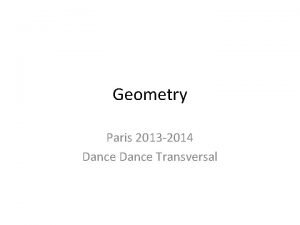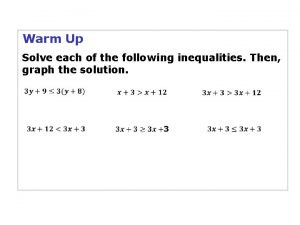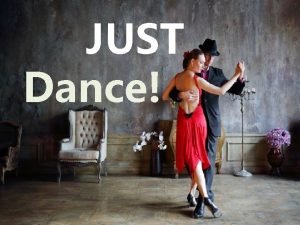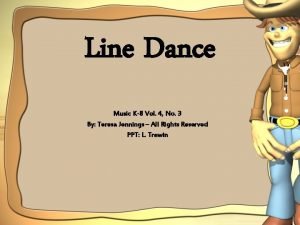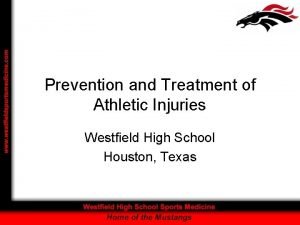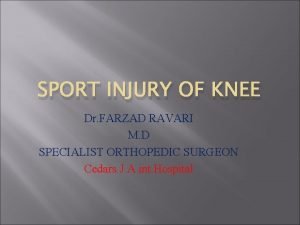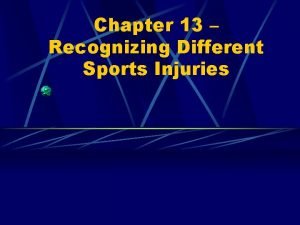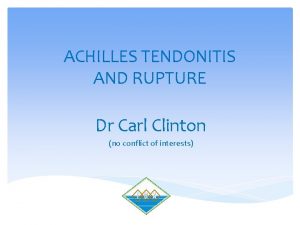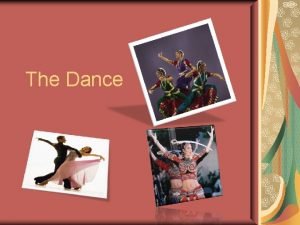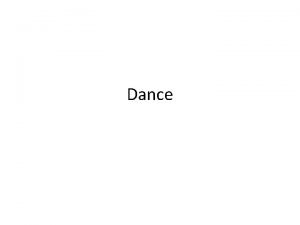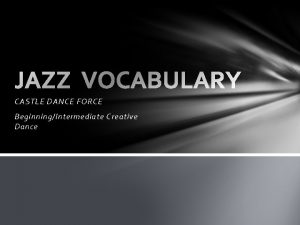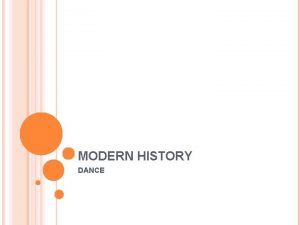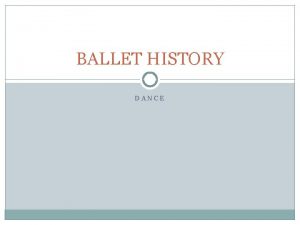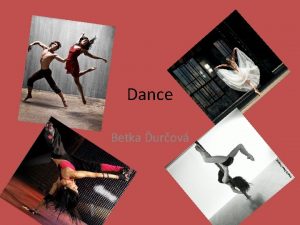Dance Injuries Dance 1 2 Mrs Lankford Miss




















- Slides: 20

Dance Injuries Dance 1 & 2 Mrs. Lankford & Miss Fleming

What is Dance? * Dance is defined as a conscious effort to create visual designs in space by continuously moving the body through a series of poses and pattern tracings. The movements must also be in sync to a particular rhythm.

3 Basic Dance Genres: 1. Classical Ballet – characterized by the turnout of the hip, rising up on the toes, elevation, beats, turns and toe dancing.

Dance Genres Cont. 2. Modern Dance – characterized by barefoot dancing, asymmetry and personal choreographic or dance styles.

Dance Genres Cont. 3. Folk Dance (including Jazz and Hip Hop) – characterized by folk rhythms and traditional dance steps from a particular area or ethnic origin.

What Defines A Dancers Body? n The professional dancer’s ideal body is typically identified by the following: Loose joints n Turnout of the leg n Slight knee hyperextension n Adequate flexion of the ankle and foot n Foot shape (“winged” foot) n

3 Fundamental Stages of a Dancer’s Career 1. The Beginning Stage * Training can begin as early as age 3 but most start to seriously train beginning at age 8. This stage will last till around 12 years old. Stress is increased gradually which allows the body to slowly adapt as the child grows. Because of this, injury during the stage is very minimal. Instructors will encourage flexibility, leg turnout and building strength in the foot and ankle.

2. The Middle Stage * This is considered the developmental stage and is usually from 12 to 16 years old. This is a period of rapid growth and progressive acceleration in training demands.

3. The Apprentice Stage * This is the start of the professional career. Dancers can begin as early as 16 -20 years old. High levels of stress are placed on a not so quite mature skeletal system. Most injuries occur during this stage because of overuse.

How are Dance related injuries evaluated? The age, sex and number of hours spent practicing all play a role in determining proper treatment to heal or prevent the recurrence of an injury. The following additional information will also need to be asked by your specialist to ensure proper diagnosis, evaluation and treatment.

1. 2. 3. 4. 5. 6. 7. 8. Date of injury Mechanism; how did it occur Pop or snap heard at the time of injury Swelling or discoloration Pain; it’s nature, location, what makes it worse Nerve symptoms; any numbness or tingling Proper footwear; pointe shoes, dance shoes Dance surface; hardwood, concrete

Most Common Dance Related Injuries 1. 2. 3. Foot/Ankle Knee Lower Back

Common Areas of Injury n Spine – Alignment is important; often dancers try to over compensate for poor turnout by arching their backs to further rotate their hips. This produces a swayback which places stress on the lower back. Spine injuries are mostly due to POOR ALIGNMENT.

Common Areas of Injury cont. n Hip – Tendonitis (inflammation of tendon and muscle) may occur due to extreme turnout, unnatural positions such as the splits, etc. Stress fractures (small cracks) may also occur.

Common Areas of Injury cont. n Knee – Forcing turnout places strain on cartilage, ligaments and capsules of the knee. Partial or full tears of muscles or ligaments around the knee may often occur when dancers are improperly trained or dancing beyond what their body can handle.

Common Areas of Injury cont. n Feet/Ankles – The feet and ankles are the most frequently injured among dancers. Sprains, breaks and tendonitis can happen to the foot and/or ankle areas due to the daily stress placed on the area.

Internal Factors That Affect Injuries n An individuals anatomy n Ones physical conditions (strength and endurance) n Any previous illness or injury

Environmental Factors That Affect Injuries Floors/Dancing Surface – too hard or soft n Rehearsal Environment – too hot or cold, adequate space, etc. n Excessive Rehearsal – fatigue, poor diet and stress n

General Suggestions To Prevent Dance Related Injuries 1. 2. 3. 4. 5. 6. 7. Warm-up properly every time. Cold muscles are more prone to injury. Drink plenty of water. Respect your body’s limits. Wear properly fitted shoes and dance attire. Perform regular strengthening exercises. Check with your teacher to insure you are holding correct form and executing moves correctly. Cool down after a dance session.

What To Do If You Injure Yourself n n Stop as soon as you fell pain or hear a “pop” sound. Treat all soft tissue injuries (bruises, sprains, etc. ) with rest, ice, compression and elevation. This is also known as the R. I. C. E. method. Seek advice from a doctor immediately. Don’t resume physical activity until you are fully healed.
 Teresa lankford
Teresa lankford Dance dance dance in the freedom we know
Dance dance dance in the freedom we know Mrs. darling was ___________ of mrs. s.
Mrs. darling was ___________ of mrs. s. They are mrs garcia and mrs castro
They are mrs garcia and mrs castro They are mrs garcia and mrs castro
They are mrs garcia and mrs castro Dance dance transversal
Dance dance transversal Inequalities warm up
Inequalities warm up Madison line dance
Madison line dance Just dance irish dance
Just dance irish dance Everybody dance and sing line dance
Everybody dance and sing line dance Westfield sports injuries
Westfield sports injuries Minisectomy
Minisectomy Kristen wilson injuries
Kristen wilson injuries Chapter 17:2 performing cardiopulmonary resuscitation
Chapter 17:2 performing cardiopulmonary resuscitation Hunger games chapter 14 summary
Hunger games chapter 14 summary Author's intent definition
Author's intent definition Unit 15:3 providing first aid for bleeding and wounds
Unit 15:3 providing first aid for bleeding and wounds Chapter 13 worksheet recognizing different sports injuries
Chapter 13 worksheet recognizing different sports injuries Chapter 13:2 preventing accidents and injuries
Chapter 13:2 preventing accidents and injuries Clinton tendonitis
Clinton tendonitis This technique requires two poles and a blanket
This technique requires two poles and a blanket





